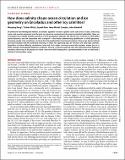| dc.contributor.author | Kang, Wanying | |
| dc.contributor.author | Mittal, Tushar | |
| dc.contributor.author | Bire, Suyash | |
| dc.contributor.author | Campin, Jean-Michel | |
| dc.contributor.author | Marshall, John | |
| dc.date.accessioned | 2023-02-17T16:54:25Z | |
| dc.date.available | 2023-02-17T16:54:25Z | |
| dc.date.issued | 2022 | |
| dc.identifier.uri | https://hdl.handle.net/1721.1/148104 | |
| dc.description.abstract | <jats:p>Of profound astrobiological interest, Enceladus appears to have a global saline subsurface ocean, indicating water-rock reaction at present or in the past, an important mechanism in the moon’s potential habitability. Here, we investigate how salinity and the partition of heat production between the silicate core and the ice shell affect ocean dynamics and the associated heat transport—a key factor determining equilibrium ice shell geometry. Assuming steady-state conditions, we show that the meridional overturning circulation of the ocean, driven by heat and salt exchange with the poleward-thinning ice shell, has opposing signs at very low and very high salinities. Regardless of these differing circulations, heat and fresh water converge toward the equator, where the ice is thick, acting to homogenize thickness variations. Among scenarios explored here, the pronounced ice thickness variations observed on Enceladus are most consistent with heating that is predominantly in the ice shell and a salinity of intermediate range.</jats:p> | en_US |
| dc.language.iso | en | |
| dc.publisher | American Association for the Advancement of Science (AAAS) | en_US |
| dc.relation.isversionof | 10.1126/SCIADV.ABM4665 | en_US |
| dc.rights | Creative Commons Attribution NonCommercial License 4.0 | en_US |
| dc.rights.uri | https://creativecommons.org/licenses/by-nc/4.0/ | en_US |
| dc.source | Science Advances | en_US |
| dc.title | How does salinity shape ocean circulation and ice geometry on Enceladus and other icy satellites? | en_US |
| dc.type | Article | en_US |
| dc.identifier.citation | Kang, Wanying, Mittal, Tushar, Bire, Suyash, Campin, Jean-Michel and Marshall, John. 2022. "How does salinity shape ocean circulation and ice geometry on Enceladus and other icy satellites?." Science Advances, 8 (29). | |
| dc.contributor.department | Massachusetts Institute of Technology. Department of Earth, Atmospheric, and Planetary Sciences | en_US |
| dc.relation.journal | Science Advances | en_US |
| dc.eprint.version | Final published version | en_US |
| dc.type.uri | http://purl.org/eprint/type/JournalArticle | en_US |
| eprint.status | http://purl.org/eprint/status/PeerReviewed | en_US |
| dc.date.updated | 2023-02-17T16:34:06Z | |
| dspace.orderedauthors | Kang, W; Mittal, T; Bire, S; Campin, J-M; Marshall, J | en_US |
| dspace.date.submission | 2023-02-17T16:34:11Z | |
| mit.journal.volume | 8 | en_US |
| mit.journal.issue | 29 | en_US |
| mit.license | PUBLISHER_CC | |
| mit.metadata.status | Authority Work and Publication Information Needed | en_US |
